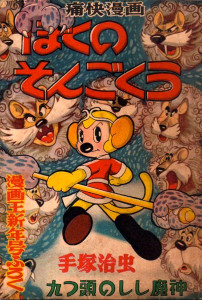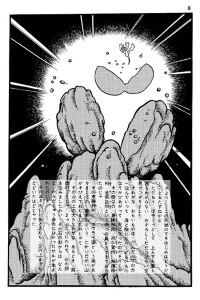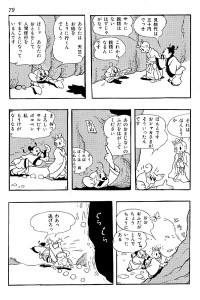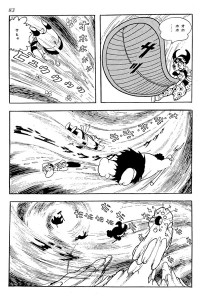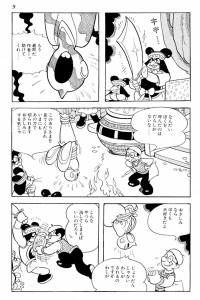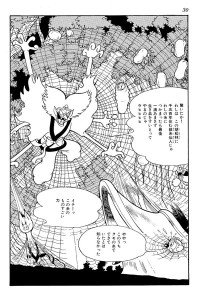Son-Goku the Monkey (Manga)
Also known as ぼくのそんごくう (Boku no Son Goku)
| English Title: | Son-Goku the Monkey |
| In English? | No |
| Japanese Title: | ぼくのそんごくう [Boku no Son Goku] |
| Type: | Ongoing Serial |
| Original run: | 1952/02 – 1959/03 |
| Published in: | Manga King [漫画王] |
| Published by: | Akita Shoten |
| Volumes: | 8 (MT-012 | MT-013 MT-014 | MT-015 MT-016 | MT-017 MT-018 | MT-019 |
Sometimes referred to as My Son-Goku, Tezuka’s take on the classical Chinese literary work, Journey to the West, tells the tale of the magical stone monkey known as Son-Goku and his adventures with the Buddhist monk Sanzohoshi as they travel to India in search of sacred Buddhist texts. Son-Goku the Monkey (1952-59) was originally published in Manga King from February 1952 to March 1959.
What it’s about
2000 years ago, deep in the heart of China, a monkey suddenly bursts forth from a stone egg atop Mt. Kaka (花果山), also known as the Mountain of Flowers and Fruits. Covered in a golden coat, his brilliance worried the gods because they could not stand the idea that something on Earth could be brighter than they. They had good reason to worry, for the strong, almost indestructible monkey with nothing to fear, quickly establishes himself as the king of the monkeys on the mountain and soon discovers a magical palace behind a waterfall. This whets his appetite for more and the monkey insists on joining the Mountain of Spirits Academy, where he begins to unlock his own magical potential. Named Son-Goku by the school’s master, the monkey’s thirst for power and rejection of authority soon brings him into direct conflict with the gods.
Son-Goku‘s playful rampage comes to an end when he is once again imprisoned in stone by the Great Buddha and told to wait for the coming of a Buddhist monk who will become his master and guide him towards wisdom. 500 years pass until a monk named Sanzohoshi happens across Son-Goku‘s prison while on his way to India to collect some sacred Buddhist scriptures. Agreeing to accompany and aid Sanzo, the pair set off, to the west, towards India. Along the way they soon encounter Tatsuko, the shape-changing daughter of the Dragon King, the gluttonous pig-like Cho Hakkai, and the sand-shifting Kappa known as Sagojô. Although they are all initially enemies, they quickly become loyal to Sanzohoshi and his quest.
With the cast now complete, the group faces many challenges on their long journey to India. They cross mountains of fire, frozen wastelands, and everything in between. They face every every kind of monster and spirit between Heaven and Earth… and almost every adventure begins with Sanzohoshi being kidnapped by the latest threat and in need of rescue by his disciples.
What you should know
Son-Goku the Monkey (1952-59) is an early example of Tezuka’s love of adapting literary classics into manga. However, unlike Faust (1950), Pinocchio (1952), Cyrano, the Hero (1953), and Crime and Punishment (1953), which are all drawn from Western literature, Son-Goku the Monkey (1952-59) is quite literally Tezuka’s take on an extremely popular tale in East Asia, Journey to the West (西遊記), also known in China as Hsi Yu Chi, in Japan as Saiyuki, and Suhyuhgi in Korea. It is one of the four major works of fiction in classical Chinese literature, and forms part of the cultural base in Asia in the same way classical Greek literature does in the west. As such, given that it was such a familiar tale to the readership when it was first released, in typical Tezuka fashion, even the title breaks through the “fourth wall” and speaks directly to the audience, telling them that this is “My (version of the) Son-Goku (tale that you already know and love)”.
The result of this was two-fold. On the one hand it gave Tezuka the freedom to employ a sort of narrative short-hand by not having to spend a great deal of time on exposition – after all, EVERYONE knows the story of Princess Iron Fan and the Fire Mountain! On the other hand, it also gave Tezuka the freedom to let his imagination run wild in certain areas with the understanding that he wouldn’t lose his audience along the way.
As such, anachronisms and out-of-context references infuse the work and can make it both challenging and rewarding for western audiences discovering the work for the first time. It also bears keeping in mind that Son-Goku the Monkey (1952-59) is very much a Tezuka work rather than simply a by-rote retelling of the original Journey to the West tale. For example, Tezuka changed Tatsuko, the dragon who transforms into a white horse for Sanzo to ride, from a male role to a female one – and just for fun had her keep the long mustaches of an Asian dragon in her horse form to act as a bridle. He also gave her much more personality than the original, making her much more “part of the team”. However, Tezuka also let himself be influenced by other interpretations of the same story. In particular, the early Chinese animated feature film, Princess Iron Fan (1941), directed by two of Tezuka’s heroes in animation, the Wan brothers, left a huge impression on the young Osamu Tezuka. As he writes in the afterword to the Osamu Tezuka Complete Manga Works edition (MT-019), “During World War II, Kodansha released a Son Goku picture book by Miyao Shigeo. While that manga helped quench my thirst during the war shortages, more than anything, China’s first animated feature film, Princess Iron Fan, released in 1942, caught my eye and left a strong impression on me and was the birth of My Son-Goku” (p 168). In particular the “Flaming Mountain” chapter of Son-Goku the Monkey (1952-59) bears a striking resemblance to the film.
However, as usual, Tezuka offers a fast-paced thrill ride, albeit one that does rely heavily on the somewhat formulaic Sanzo kidnapped/rescued plot device. It is interesting to note, Tezuka was very much aware of this fact and as a result, Son-Goku the Monkey (1952-59) also features an early example of something he would eventually become well known for – appearing as himself in his own manga. In one of the later chapters, Sanzo finally fed up with yet again being placed in imminent danger, calls on Tezuka to resolve the situation once and for all. Tezuka, the manga creator himself, appears, uses his handy eraser to clear up the problem at hand, begins a “white space” discussion, and basically suggests that Sanzo is overreacting because Son-Goku ALWAYS shows up in time to rescue him. To this Sanzo replies, that if Tezuka thinks it is so easy, than HE should try it for a while, and then proceeds to switch places with the manga artist. The story then resumes with Osamu Tezuka now cast in the Sanzo role, with none of the other characters any the wiser. In this way, by not just breaking, but shattering the “fourth wall“, Tezuka allows his readers (and one assumes himself) to form a deeper connection with the work. Actually giving them permission to insert themselves into the story and thus experience it on a whole new level.
Tezuka’s Son-Goku the Monkey (1952-59) remains a very influential manga work. Although drawing from the same literary source, certain elements of Akira Toriyama‘s uber-popular manga Dragonball (1984-95) – in particular the design of Son-Goku‘s cloud vehicle and magic staff – suggest a strong Tezuka influence. Also, Rumiko Takahashi‘s popular manga Inuyasha (1996-2008) shares a similar “band of heroes happen upon a village and end up freeing it from the yoke of a local demon” theme, and even includes an item of jewelry (Son-Goku‘s headband to Inuyasha’s necklace) that lets the leader of the band control the story’s somewhat rambunctious hero.

